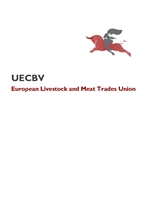AEMB
| UECBV Position on new Animal Transport Proposal |
7 December 2023


Animals are key - our focus is on health and welfare
Assuring animals’ transportation at best quality
Assuring animals’ transportation at best quality
- UECBV is one of the first signatories of the EU Code of Conduct on Responsible Food Business and Marketing Practices since 7/2021 and therefore further committed to searching for further solutions to ensure best possible health and well-being to the animals in our care.
- UECBV supports a strict and harmonised implementation and official controls of the current EU animal welfare rules in contrast to additional legislation.
- UECBV supports the global ‘One health approach’ and is always looking to play its active part in sustainably balancing and optimising the health of people, animals and ecosystems.
Comments on the proposal on animal welfare in transport published by the European Commission
The proposal for increasing animal welfare in transport comes as an initiative with a welcome target and intention, still it will need to be adapted to make it realistic and truly future driven.
This proposal for a new regulation means improvements for the European welfare standard for animals, but also a huge challenge for all the actors in the value chain.
The exports of live animals to third countries are a key activity for the sector that allows farmers and traders to soften the impact of internal trade disruptions. But events like those we witnessed a few years ago cannot happen again. It is important to preserve the welfare of animals during these journeys at the time to preserve the reputation of our sector. For this reason, we welcome the proposed changes.
The digital transformation of transport operations is also a necessary step to take together with the European Commission and the commitment of Member States but also operators. The data protection in this context is also welcome as it is a paramount piece for a safe trading.
However, other aspects of the draft seem to be extremely challenging or unlikely to be put in practice without jeopardising several segments of the value chain.- Journey times proposed are not sufficient to cover the needs of the whole value chain. Limiting the journey times prevents farmers from other regions from developing the activity for which they are specialised. For the case of slaughter, the proposal could force the closure of slaughterhouses for lack of supply.
- Increasing space allowances and overhead space is not only a cost issue (doubling the cost of transport), but also a problem of risk of injuries during the journey. Decreasing the density of animals increases the probability of falling in accelerations, breaking, or turning. In addition, overhead space allows bovines to mount each other, increasing the risk of this accident.
- Minimum ages foreseen in the draft would jeopardise traditional products in some Member States.
The transitional periods foreseen in the draft should be accompanied by financial support for a smooth adaptation and should be long enough to allow operators to adapt to the new circumstances.
Why long-distance transport of live animals is needed
Key messages
Why is there long-distance transport of live animals – intra-EU
1. Taking into account that a journey time includes time of loading and unloading, an eight-hour journey becomes more or less 5 hours. In 5 hours you can travel around 300 km. So it is very normal to see long-distance transport even within an EU MS;
2. Specialisation of regions in productions systems (e.g. fattening of calves in the Netherlands), or travelling to slaughterhouses (as they are clustered around regions);
3. Pushing non-specialised areas to produce animals can have a big environment impact as there is a reason why these areas are not specialised versus the others which are. Specialised areas have, in a lot of situations, become like this due the conditions of the land and/or a symbiosis with other production systems or industries. Not respecting this could lead to an increased environmental impact and less efficient use of resources.
Why is there long-distance transport of live animals – export
It is a multi-factorial issue. However, the main one is demand. The industry in importing countries needs live animals not meat. They are two different industries and supply chains. Other factors are:
1. Religious slaughter procedures;
2. Problems in cold chain and supply chain for meat;
3. Different use of carcasses and cuts;
4. Easier market access for live animals than for beef;
5. Sometimes import taxes are bigger for meat than for live animals.
It is also important to remember that past situations showed that if EU bans the export of live animals, it will not be replaced by meat exports, but by exports of live animals by other countries (e.g. Brazil). By doing this we are not improving the situation but making it worse. EU’s view should be global.

